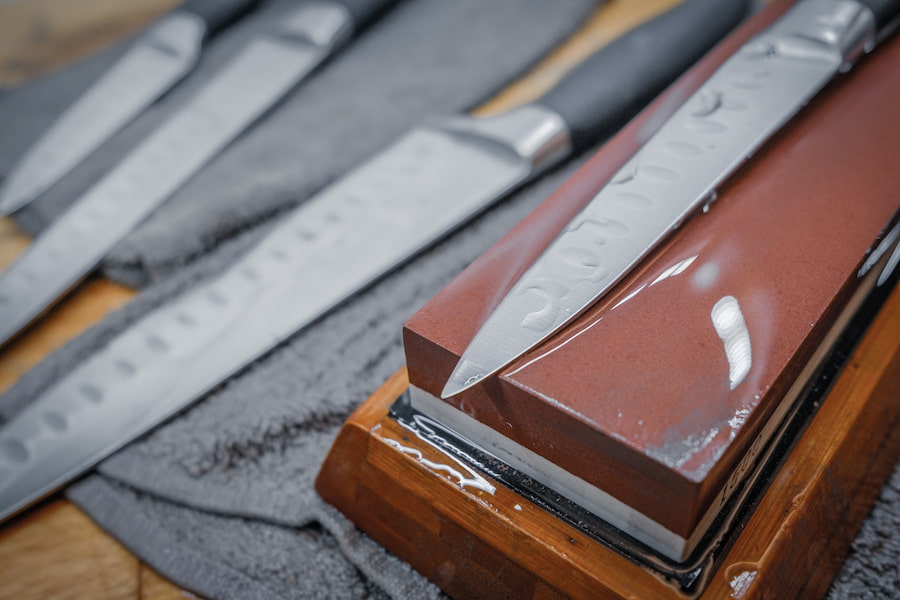As an Amazon Associate we earn from qualifying purchases.
Many people focus on cleaning their knives and keeping them in top shape. They often forget the whetstone leaving it to accumulate a lot of debris over time, and it may end up changing its color. Everyone should have an idea on how to clean a whetstone; if you don’t, read on.
Contents
How to Clean a Whetstone
One of the easiest ways to know that your whetstone needs cleaning is glossy gray streaks that will become prominent as it becomes dirtier. Investing a little of your time cleaning the whetstone will pay off in the long run. A well-maintained whetstone often translates to well-maintained knives.

There is no set schedule of when you should be cleaning your whetstone. How often you clean it will depend on:
- How frequently do you sharpen your knives
- The type of material the stone is made of
- What do you use to clean it
Focus on cleaning it as you notice the pores become clogged. This is when the grayish color will start showing. The following are ways you can use to clean your whetstone.
Use Honing Oil and Warm Water
This is one of the most comprehensive ways of cleaning your whetstone. For this process, you will need:
- Paper towels
- Honing oil
- WD-40
- Warm soapy water
- Toothbrush
- Steel wool
Step 1: Set Up
Before you do anything else, place a paper towel under the whetstone. This is to catch debris and reduce the amount of time you will have to take to clean the space that you use.
Step 2: Use Honing Oil
Pour a generous amount of honing oil on the surface of the whetstone and use the toothbrush to spread evenly. Apply it in gentle, circular motions, do not be vigorous. Make sure that all the surfaces have been covered evenly.
After some time, you will notice grey flecks coming out of the pores of the whetstone. Apply the honing oil one more time to make sure that you remove all the flecks. Using a paper towel, wipe all the flecks until there are none left on the surface of the whetstone.
At this stage, the goal is to remove the dirt and metal shavings in the pores of the whetstone. Some people tend to replace honing oil with refined mineral oil. Ensure you do not apply a lot of honing oil.
Step 3: Use WD-40
Flushing the metal shavings from the pores of the honing oil brings them to the surface. To clean them off the surface, you need to use WD-40. This oil works well mainly when it comes to penetrating tough surfaces but you can also use this to clean a rubber watchband, chalky plastic lawn chairs, drum heads, and melted plastic from the oven.
When using WD-40, ensure that you use it in a well-ventilated area. It leaves a foul odor. At the same time, do not use spray cans when using them. The best alternative is pump bottles, as they do not have fluorocarbons.
Spray it on the surface of the whetstone and let it sit for approximately 10 minutes.
Step 4: Use Steel Wool
After the 10 minutes have elapsed, use fine steel wool and scrub all the surfaces. Pay close attention to the edges. Scrub until all the dirt is loose on the surface.

Step 5: Rinse With Warm Soapy Water
After scrubbing with steel wool, all the dirt will be loose and on the surface, rinse the whetstone with warm water. If you notice some grime during rinding, scrub it again using steel wool or a toothbrush.
If the honing oil you used was petroleum-based, use oil to clean your whetstone. Using water after using petroleum-based honing oil will not work effectively. Only rinse with warm soapy water if you use a water-based honing oil.
Step 5: Pat Dry
Use paper towels to dry the whetstone. Carefully pat it until it dries. Once done, you will have a clean whetstone.
Use Warm Water and Soap
This method works well with whetstones that have not been in use for a long time and do not have a lot of buildup of dirt and metal. If you have used it for a short time or are still new, this would be the best-suited method.
For this, you will need:
- Soap
- Warm Water
- Toothbrush
- Paper towels
Follow the following steps:
- Make the whetstone wet using warm water and soap.
- Using the toothbrush, scrub all the surfaces paying extra attention to areas that seem to have more build-up.
- Add more soap and water when needed. Scrub until all the metal shavings and sort become loose.
- Rinse off all the loose dirt using warm water.
- Thoroughly dry the whetstone using paper towels. If you do not dry it properly, chances are, it will corrode or rust. You can also let it air-dry.
- Return it in its sheath and store it in a dry place.
Use Scotch Brite Pads
If you do not want to use soapy water, Scotch Brite pads will do the trick. Wet the pad and then begin scrubbing the whetstone; scrub evenly until all the dirt becomes loose. Rinse and if there is still dirt, go back to scrubbing.
Rinse and then use paper towels to dry it off. A piece of cloth will work just fine as long as you do not leave any moisture on it. If this is your cleaning method of choice, wash it often.
If you stay for a long time without cleaning it, you will end up spending a lot of time on it.
Use a Toothbrush
This method is economical. It will save you from going to the store; you can use an old toothbrush that you no longer use. You do not need to use any soap or warm water.
All you need is running water and your toothbrush. Wet the whetstone and then begin scrubbing it. Do not use a lot of force. If the metal fillings and dirt are not coming out of the pores, soak it for about 20 minutes. If you soak it for a long time, you have to dry it for a long time.
After the time has elapsed, continue with your scrubbing process. On completion, wipe it using a paper towel until it dries. This method may not work as well as the other methods.

How to Flatten Your Whetstone
After continuously sharpening your tools, such as knives, for a long time, you will notice your whetstone becoming hollow in the middle part. This will make the sharpening process difficult, and your tools will become round at the edges when you sharpen them.
To prevent this, you have to flatten your whetstone. You can do this after using it ten times. Better yet, before you start using your whetstone, take the first few minutes to flatten the whetstone. When it is flat, you will notice a difference in the sharpening process.
The following are ways you can flatten your Whetstone:
Use a Flattening Plate
Before you begin, moisturize your whetstone using oil or water. A dry whetstone does not get flattened easily. When purchasing a whetstone, some brands come with a flattening plate. If yours did not, you could purchase a silicon-carbide one.
If your whetstone is synthetic, replace water with honing oil. Synthetic whetstones are grittier than natural stones. You must know the type of stone your whetstone is made of. Place the flattening plate on a flat surface. You may want to put paper towels under it.
Place the whetstone on the flattening plate and then gently move it back and forth. Do this until you feel like the surface is now uniform. You can mark it with a pencil so that once you see that all the marks have disappeared, you will be able to tell it is flat.
Use a Sandpaper
If you do not have a flattening plate, 100-grit sandpaper will work just fine. Place it on a flat surface where it will not keep on moving during the sanding process. Next, make your whetstone damp using oil or water.
Rub the stone on the sandpaper until the surface becomes smooth and there are no metal filings. You can also use the pencil method to know when it is flat.
Proper Ways to Maintain Your Whetstone
Cleaning and flattening are ways to ensure that your whetstone serves you for a long time. Other things that can you can include:
- Use it for the proper purpose. Just because it is a sharpening tool does not mean it should sharpen everything. Stick to tools in your kitchen.
- Use it correctly. One of the most common mistakes is sharpening your knife at the wrong angle. A low angle ends up removing more metal than you need to. This drastically lowers the whetstone’s lifespan.
- Use it when it is not at the same level as the surface. This may cause it to slip and may cause accidents.
Conclusion
A whetstone is a kitchen must-have. Like all the things in the kitchen, it needs to be kept clean at all times. A dirty whetstone may cause problems for the entire household.
Learn how to clean it properly and to maintain it, and it will serve you for a very long time.
